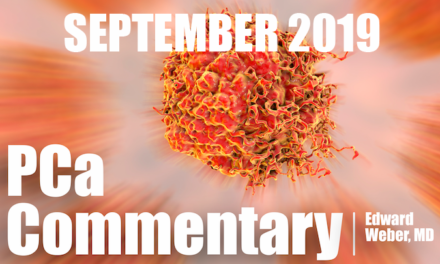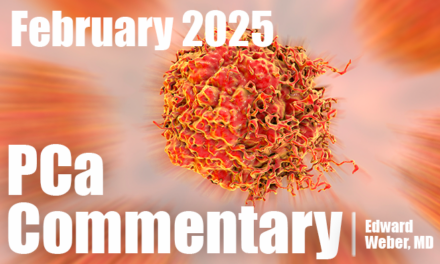
PCa Commentary | Volume 154 – June 2021
Posted by Edward Weber | June 2021
Treatment-Induced Neuroendocrine Prostate Cancer —
Tough to Diagnose and Tough to Treat: A Primer but Concluding with a Review of a New Study Offering Hope.
Neuroendocrine Prostate Cancer: What is it?
Under the sustained and intense suppression of testosterone with Lupron or Degarelix – and now with the even stronger suppression with drugs like Xtandi and Zytiga, prostatic adenocarcinoma may undergo a therapy-induced genomic change. This adaptive response to treatment usually develops in the later metastatic stages of cancer. The incidence of NEPC is rising due to the common and prolonged use of the more potent androgen receptor pathway directed agents. This ‘transdifferentiation’ to t-NEPC changes the microscopic appearance, biologic and genomic behavior of the prostate cancer cells so that they no longer express PSA. NEPC loses all or most of the surface expression of PSMA and acquires resistance to androgen receptor pathway inhibitors. NEPC develops in 20% – 25% of men with mCRPC (Gleave et al., Int. Journal Urology. Feb 2018, “Clinical and molecular features of treat-related neuroendocrine prostate cancer,”) [an excellent reference]. Metastatic sites can contain a mixture of the transdifferentiated NEPC (tNEPC) cells and the conventional adenocarcinoma presenting a challenge in treatment decisions. tNEPC, when extensive, is associated with a PSA value lower than would be expected relative to the extent of disease, and often involves visceral sites such as bulky liver lesions and multiple lytic bone metastasis. The behavior is aggressive.
How Does NEPC Develop?
A scattering of benign neuroendocrine cells normally inhabits the prostate gland. It is not known if these cells undergo transdifferentiation and clonal expansion and accompany prostate cancer cells in their malignant trajectory. The more accepted theory is that mCRPC cells experience an awakening of latent genomic instructions that influence the transdifferentiation to t-NEPC.
Research by Quaglia et al. found that small extracellular vesicles from adenocarcinoma cells can induce neuroendocrine differentiation in nearby cancer cells (Journal of Extracellular Vesicles. 2020). This transdifferentiation is termed ‘lineage plasticity’ and confers aggressive stem-cell properties to the transformed cells (Davie et al., Nature Reviews Urology. Feb 2018, “Cellular plasticity and the neuroendocrine phenotype in prostate cancer”).
In rare instances, 2%, highly malignant NE cells (pure NEPC) comprise the entirety of the prostate at diagnosis. In this instance the cells resemble and behave like the aggressive small cell lung cancer. Treatment requires radiation and chemotherapy, i.e., platinum compounds alone or in combination. Androgen suppression is ineffective. Survival is short.
How is treatment-induced NEPC Diagnosed?
In the setting of metastatic CRPC it is challenging to detect clinically significant aggressive NEPC elements mixed with adenocarcinoma. Currently, (but see DeLucia below) there are no distinctive serum markers like the PSA and the unique cell surface imaging target such as the PSMA.
An above normal baseline serum chromogranin A is suggestive of t-NEPC especially if it increases during treatment (Szarvas et al., BJU Int. 2020). Whereas the suggestion that the combination of a low PSA in relation to an inappropriately extensive tumor burden is clinically apt, it is a nonspecific clue that is subjective in application. Dr. Beltran (Dana Farber Cancer Institute) is researching the use of circulating tumor DNA as a non-invasive means to diagnosis NEPC (ASCO GU #GU20).
A cell surface somatostatin receptor (SSTR) on NEPC has been the target of much research to develop a 68-Gallium binding compound to facilitate PET imaging of t-NEPC. The sensitivity, however, has been diagnostically inconsistent with “just 30% of focal metastases showing SSTR overexpression” (Savelli et al. Int Journal Urol. 2019). Because of the high proliferative growth rate t-NEPC cells are avid for glucose and can be imaged with an F18-deocyglucose PET/CT (FDG). In some imaging studies patients were scanned with both the PSMA PET/CT and the 18F-FDG scan. Those men who showed FDG uptake were thought to be poor candidates for radioligand therapy with 177LU-PSMA because high FDG uptake suggests a significant presence of t-NEPC.
Ultimately, a biopsy of a metastatic lesion can be diagnostic based on staining for chromogranin A, neuron specific enolase and synaptophysin.
A Promising New Study from the Fred Hutchinson Cancer Research Center, Seattle:
In Clinical Cancer Research, Feb. 2021, Dr. DeLucia and colleagues presented “Therapeutic Efficacy of An Antibody—drug Conjugate in Neuroendocrine Prostate Cancer.” Their investigation focused on a cell surface marker, CEACAM5, expressed in late-stage prostate cancer. They found that “CEACAM5 expression was enriched in NEPC compared with other mCRPC subtypes and minimally overlapped with prostate-specific antigen [and] prostate stem cell antigen….” CEACAM5 is expressed in over 60% of NEPC and has limited systemic expression.
The drug conjugate labetuzumab govitecan combines the cell-surface marker-seeking antibody anti-CEACAM5 – SN38 with a commonly used prodrug irinotecan. “Labetuzumab govitecan induced DNA damage in CEACAM5+ prostate cancer cell lines and marked antitumor responses in CEACAM+ CRPC xenograph models including chemotherapy-resistant NEPC.”
The association of serum CEA levels (CEA is a marker commonly elevated in colon cancer) with CEACAM5 positivity is being further investigated as a potential diagnostic test for NEPC in the proper clinical setting. “The results of the studies have led to planning for a forthcoming phase I/II clinical trial of labetuzumab govitecan for patients with CEACAM positive NRPC.”
Treatment Considerations:
Men who are found at diagnosis or later in their disease to have metastases in liver, lung, or bone and have an elevated CgA are likely to be found on biopsy to have small cell-like NEPC. The NCCN guidelines recommend combination chemotherapy with a platinum compound combined with etoposide or docetaxel.
For those men who later in their disease develop a mixture of t-NEPC and adenocarcinoma the treatment is more problematic. Gleave (ibid) comments: “… PCa mixed with NE marker-positive cells should be given standard hormone therapy (either with or without chemotherapy) depending on the clinical context.” It remains an unresolved issue whether an element of t-NEPC mixed with adenocarcinoma confers an additional adverse treatment outcome beyond the recognized risk of intermediate-and high-risk PC – as discussed in Antonarakis et al., The Prostate. 2020.
BOTTOM LINE:
The increased use of commonly used potent anti-androgens is associated with a rising incidence of t-NEPC in combination with the usual type of adenocarcinoma. The lack of definitive serum markers and PET scan targets to identify NEPC hampers diagnosis and renders treatment decisions challenging in this highly aggressive disease.
Your comments and requests for information on a specific topic are welcome e-mail ecweber@nwlink.com.
Please also visit https://prostatecancerfree.org/prostate-cancer-news for a selection of past issues of the PCa Commentary covering a variety of topics.
“I want to thank Dawn Scott, Staffperson, Tumor Institute Radiation Oncology Group, & Mike Scully, Librarian, Swedish Medical Center for their unfailing, timely, and resourceful support of the Commentary project. Without their help this Commentary would not be possible.”
ABOUT THE AUTHOR
Edward Weber, MD, is a retired medical oncologist living in Seattle, Washington. He was born and raised in a suburb of Reading, Pennsylvania. After graduating from Princeton University in 1956 with a BA in History, Dr. Weber attended medical school at the University of Pennsylvania. His internship training took place at the University of Vermont in Burlington.
A tour of service as a Naval Flight Surgeon positioned him on Whidbey Island, Washington, and this introduction to the Pacific Northwest ultimately proved irresistible. Following naval service, he received postgraduate training in internal medicine in Philadelphia at the Pennsylvania Hospital and then pursued a fellowship in hematology and oncology at the University of Washington.
His career in medical oncology was at the Tumor Institute of the Swedish Hospital in Seattle where his practice focused largely on the treatment of patients experiencing lung, breast, colon, and genitourinary cancer and malignant lymphoma.
Toward the end of his career, he developed a particular concentration on the treatment of prostate cancer. Since retirement in 2002, he has authored the PCa Commentary, published by the Prostate Cancer Treatment Research Foundation, an analysis of new developments in the prostate cancer field with essays discussing and evaluating treatment management options in this disease. He is a regular speaker at various prostate cancer support groups around Seattle.




